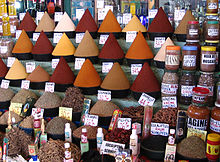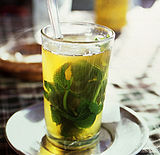Moroccan cuisine: Difference between revisions
| Line 85: | Line 85: | ||
* [http://www.cookingwithalia.com/ cookingwithalia.com] Moroccan cuisine videos |
* [http://www.cookingwithalia.com/ cookingwithalia.com] Moroccan cuisine videos |
||
* [http://flavorsofmorocco.com/ Flavors of Morocco] Gourmet Moroccan Baking Mixes |
* [http://flavorsofmorocco.com/ Flavors of Morocco] Gourmet Moroccan Baking Mixes |
||
* [http://www.bargache.com] Moroccan Cuisine Encyclopedia by famous TV Show Host Abderrahim Bargache |
|||
{{cuisine}} |
{{cuisine}} |
||
Revision as of 10:31, 19 November 2010
Moroccan cuisine is extremely diverse, thanks to Morocco's interaction with other cultures and nations over the centuries. Moroccan cuisine has been subject to Berber, Moorish, Mediterranean, and Arab influences. The cooks in the royal kitchens of Fez, Meknes, Marrakesh, Rabat and Tetouan refined it over the centuries and created the basis for what is known as Moroccan cuisine today.
Ingredients
Morocco produces a large range of Mediterranean fruits and vegetables and even some tropical ones. Common meats include mutton and lamb, beef, chicken, camel, rabbit and seafood, which serve as a base for the cuisine.
Characteristic flavourings include lemon pickle, cold-pressed, unrefined olive oil and dried fruits. It is also known for being far more heavily spiced than Middle Eastern Cuisine.
Use of spices

Spices are used extensively in Moroccan food. While spices have been imported to Morocco for thousands of years, many ingredients, like saffron from Tiliouine, mint and olives from Meknes, and oranges and lemons from Fez, are home-grown. Common spices include karfa (cinnamon), kamoun (cumin), kharkoum (turmeric), skinjbir (ginger), libzar (pepper) , tahmira (paprika), anise seed, sesame seeds, qesbour (coriander), maadnous (parsley), zaafran beldi (saffron) and mint.
Structure of meals
The midday meal is the main meal, except during the holy month of Ramadan. A typical meal begins with a series of hot and cold salads, followed by a tagine. Bread is eaten with every meal. Often, for a formal meal, a lamb or chicken dish is next, followed by couscous topped with meat and vegetables. A cup of sweet mint tea usually ends the meal. Moroccans usually eat with their hands and use bread as a utensil.
Main dishes

- See also: List of Moroccan dishes
The main Moroccan dish most people are familiar with is couscous, an old delicacy probably of Berber origin.
Beef is the most commonly eaten red meat in Morocco. Lamb is preferred, but rarer thanks to its high cost. Poultry is also very common, and the importance of seafood is increasing in Moroccan food. North African sheep breeds store most fat in their tails, which means that Moroccan lamb does not have the pungent flavor that Western lamb and mutton have.
Among the most famous Moroccan dishes are Couscous, Pastilla (also spelled Bsteeya or Bestilla), Tajine, Tanjia and Harira. Although the latter is a soup, it is considered as a dish in itself and is served as such or with dates especially during the month of Ramadan.
Salads
Salads include both raw and cooked ingredients, served either hot or cold.[1] Cold salads include zaalouk, an eggplant and tomato mixture, and taktouka (a mixture of tomatoes, green peppers, garlic and spices).[1]
Desserts
Usually, seasonal fruits rather than cooked desserts are served at the close of a meal. A common dessert is kaab el ghzal ("gazelle's horns"), a pastry stuffed with almond paste and topped with sugar. Another is " Halwa shebakia ", pretzel-shaped dough deep-fried, dipped into a hot pot of honey and sprinkled with sesame seeds. Halwa Shebakia are cookies eaten during the month of Ramadan. Coconut fudge cakes, 'Zucre Coco', are popular also.
Drinks

The most popular drink is green tea with mint. Traditionally, making good mint tea in Morocco is considered an art form and the drinking of it with friends and family is one of the important rituals of the day. The pouring technique is as crucial as the quality of the tea itself.
Moroccan tea pots have long, curved pouring spouts and this allows the tea to be poured evenly into tiny glasses from a height. For the best taste, glasses are filled in two stages. The Moroccans traditionally like tea with bubbles, so while pouring they hold the teapot high above the glasses. Finally, the tea is accompanied with hard sugar cones or lumps.
Snacks and Fastfood

Selling fast food in the street has long been a tradition, and the best example is Djemaa el Fna square in Marrakech. Starting in the 1980s, new snack restaurants started serving "Bocadillo" (a Spanish word for a sandwich, widely used in Morocco). Though the composition of a bocadillo varies by region, it is usually a baguette filled with salad and a choice of meats, fish (usually tuna), or omelette.
Dairy product shops (Mahlaba in Moroccan Arabic) are open throughout cities in Morocco. Those mahlabas generally offer all types of dairy products, juices, and breakfasts as well as bocadillos, competing with former established snack restaurants.
In the late 1990s, several multinational fast-food franchises opened restaurants in major cities.
Moroccan food abroad
Couscous is one of the most popular North African dishes globally. Markets, stores and restaurants in Europe, especially in France and lately the UK feature lamb tajines, bastilla, and couscous.
Gallery
-
Eggplant turnovers, tomato rice, lentils and saffron rice
-
Moroccan spreads
-
Pickled lemons called "country lemon" or "leems", a Moroccan delicacy
-
Moroccan lamb with prunes and apricots
See also
- List of Moroccan dishes
- Middle Eastern cuisine
- Mediterranean cuisine
- Jewish cuisine
- Berber cuisine
- Culture of Morocco
References
- ^ a b Zeldes, Leah A. (Nov. 11, 2009). "Eat this! Zaalouk, a cooked salad from Morocco". Dining Chicago. Chicago's Restaurant & Entertainment Guide, Inc. Retrieved Nov. 12, 2009.
{{cite web}}: Check date values in:|accessdate=and|date=(help)
Recipe books
- Cooking at the Kasbah: Recipes from My Moroccan Kitchen, by: Kitty Morse, Laurie Smith ISBN 0-8118-1503-X
- Scent of Orange Blossoms: Sephardic Cuisine from Morocco, by: Kitty Morse, Owen Morse ISBN 1-58008-269-6
- Couscous and Other Good Food from Morocco, by: Paula Wolfert, Gael Greene ISBN 0-06-091396-7
- Food of Morocco: Authentic Recipes from the North African Coast, by: Fatema Hal ISBN 962-593-992-X
- Cuisine des palais d'orient, by: Alain Mordelet ISBN 2-87678-868-3
External links
- Template:Dmoz
- Moroccanlinx.com Moroccan cuisine videos
- cookingwithalia.com Moroccan cuisine videos
- Flavors of Morocco Gourmet Moroccan Baking Mixes
- [1] Moroccan Cuisine Encyclopedia by famous TV Show Host Abderrahim Bargache




